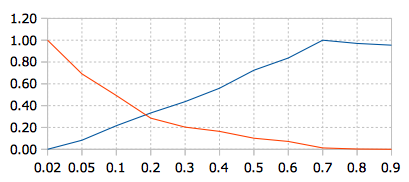I'm trying to understand a tradeoff that came up to me when I'm studying an algorithm used to distribute a load in a distributed system. The tradeoff involves network communication and make span.
More general, I have two measured features (Cost and Network usage) in function of a parameter (P), with the following values:
P Cost Network Norm.Cost Norm. Network 0.02 165861 120475244 0.00 1.00 0.05 370734 111585613 0.08 0.69 0.1 700087 105874552 0.22 0.49 0.2 988711 99895161 0.33 0.29 0.3 1245062 97533787 0.44 0.20 0.4 1549184 96407051 0.56 0.16 0.5 1957080 94602881 0.72 0.10 0.6 2233933 93743271 0.84 0.07 0.7 2637193 92035416 1.00 0.01 0.8 2563590 91746277 0.97 0.00 0.9 2523726 91680622 0.95 0.00
The plot of normalised values is:
In my scenario, choosing P depends on the limit of network bandwidth and the cost that can be take. However, there is a general theory about that cross point? What it indicates? It is statistically correct (and commonly used) to show this chart or there is a better way?

